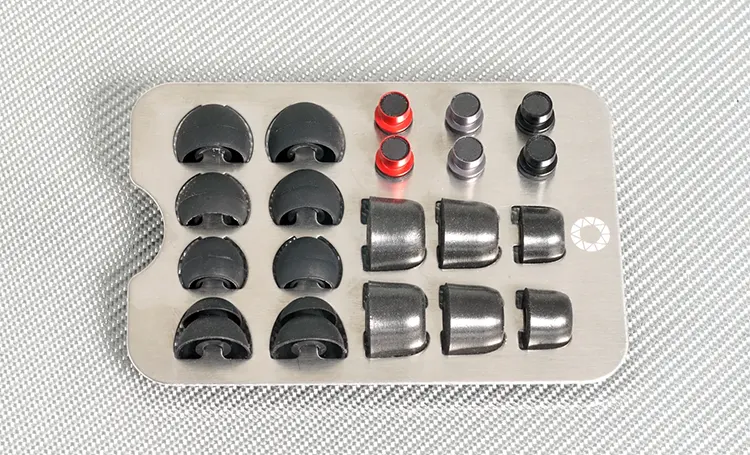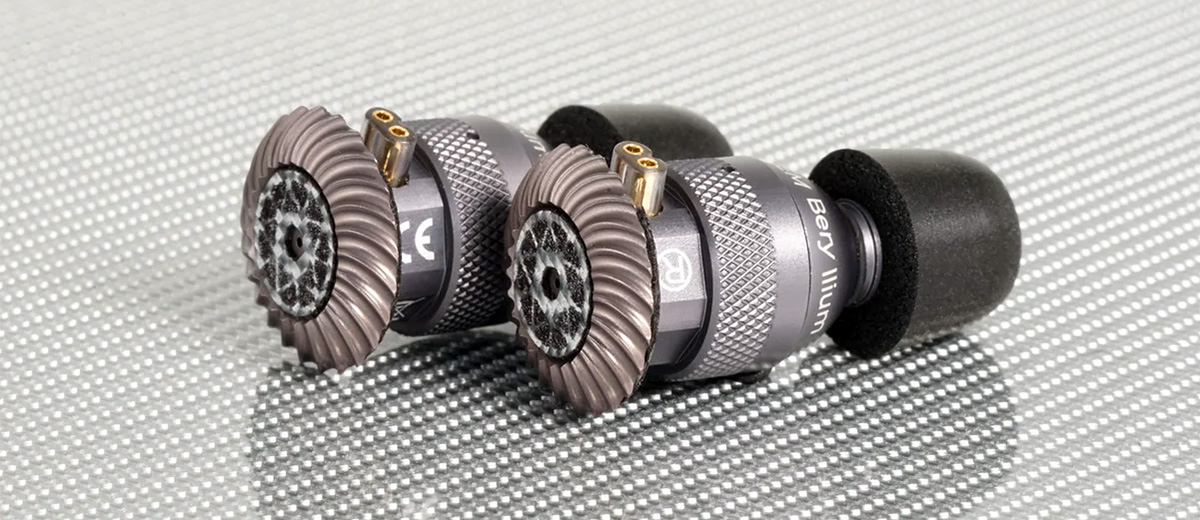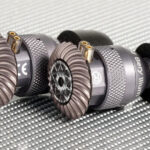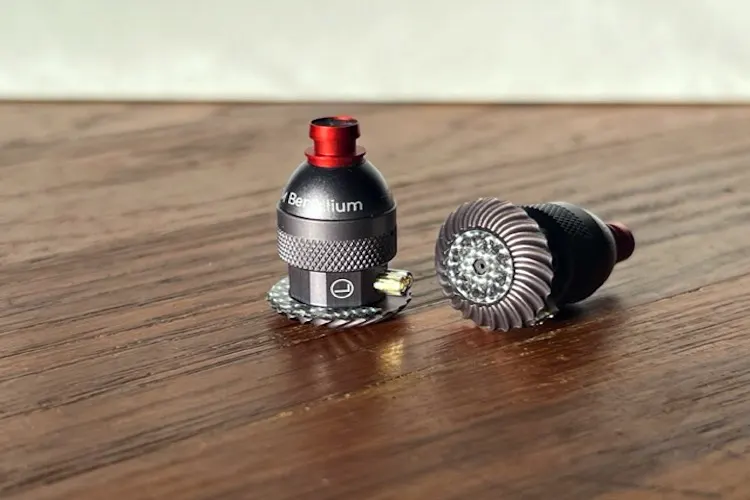In this feature, we review the Spirit Torino IEM Twin Pulse Beryllium, which is a high-end isobaric-configured dynamic driver universal IEM. It is priced at €1000.
Disclaimer: This sample was sent to us in exchange for our honest opinion. Headfonics is an independent website with no affiliate links or services. We thank Spirit Torino for their support.
To read more about IEMs previously assessed on Headfonics click here.
Note that this article follows our current scoring guidelines which you can read in more detail here.
The IEM Twin Pulse from Spirit Torino is the company’s first IEM and uses its proprietary dynamic driver system based around an isobaric chamber with dual beryllium drivers.
Known for producing flagship-level headphones, the IEM Twin Pulse falls into the lower end of high-priced IEMs, using the same technology as their more well-known headphones.
This is the first Spirit Torino model we have reviewed, and so far, the initial offering is quite good.

Tech Highlights
Driver Configuration
The IEM Twin Pulse uses the same inertial frame technology found in two of the company’s headphones, the Twin Pulse and Twin Pulse Pro.
The Twin Pulse Motor Assembly employs two identical crossover-free 10mm micro dynamic drivers with neodymium magnets and Beryllium-treated membranes acting synchronously to zero out typical micro-acoustic problems and phase interference.
The treated membranes ensure that both drivers work together, with a fast response time to the sound signal.
To allow this tech to function correctly at a fraction of the size, Spirit Torino introduced a bullet-type design along with custom venting ducts and some clever internal acoustical chamber engineering to keep distortion to a minimum.
Some of that engineering also includes anti-resonant treatment of the inertial frame which takes the form of a series of stunning-looking Texalium composite inserts.
Filters
Changeable filters, (red, black, and gray), help to fine-tune the sound as well. Gray for a linear studio response, red for a response with +3dB in the low range, and black for a response with -3dB in the low range.
While not as much as some changeable filtered IEMs, the differing filters did promote their own signature onto the overall sound.
Design
The Twin Pulse is a three-major pieced IEM, with the main shell, sound extractor (bulbous semi-cone), and filter.
Shaped like a long, artistic cylinder, the faceplate is adorned with the Texalium inserts as well as the Spirit Torino recognizable shiny, multi-starred insert. Surrounding the star is a gray/bronze cog-like wheel, giving the IEM a distinct and quite exquisite look.
The IEM comes standard with two cables a 3.5mm SE and 4.4mm balanced cable as well as a 6.35mm single-end adapter.
Comfort and Isolation
The cylindrical shape of the Twin Pulse means that you can move the IEM around for a better fit. With traditionally shaped shells, you are held to the shape, which may or may not match your ear canal and inner ear shape.
The Twin Pulse fits relatively deep using the included medium foam tips. I was able to achieve a solid seal, with minimal outside noise penetrating the listening.
When properly fit in my ears, the Twin Pulse did not stick out as far as some, with the right IEM coming out a bit further due to the narrowness of my right ear canal.
With that ability to move the Twin Pulse around, you should be able to get a good fit, and tip choice will allow excellent isolation.

Tips Choices
The seven included sets of tips should allow for most-sized ears to achieve the same isolation.
Switching to the included silicon tips, I moved up to the large size and attained the same level of isolation as the medium foam. I do wish Spirit included more than one size of double-flange, as I have a feeling this would have been ideal using the gray neutral filter.
The foam tips remind me of Comply-type tips, with excellent feel and compression. On the softer side, rolling them allowed for an excellent seal.
Silicon tips fit very well, once I moved to the large size as mentioned; although they were harder to mount on the thicker flange of the filters.
The smaller-sized silicon tips allowed for a deeper penetration into the ear canal, somewhat countering the small size in terms of isolation. But their diameter was too small to get a good fit.
The double flange only came in a medium size, which was a smidge too small for my ears to give a good seal. As a result, I used the medium foam and large single-flange silicon tips for testing purposes (mostly the foam).

Stock Cable
The Twin pulse comes with two stock cables, as opposed to interchangeable jacks. Both are of good quality in 392-strand spun Litz OCC silver-plated four-wire. With supple pliability, the cables tangled very little and lay properly without being too stiff.
The jacks were made with a carbon insert, not unlike many custom cables on the market, but of note was the inner plastic protection coming out of the jack.
Cut evenly and with a good thickness to it, the craftsmanship of the jack showed. Often that protection piece is cut haphazardly, so it was nice to see care taken in the build of the jack.
The four-strand cable, which is loosely wound did not look sloppy or become unmanageable but I did wish for a slightly tighter wind. Above the Y-splitter, the two-strand wire was wound tighter; preventing any potential issues of snagging in my opinion.
The silver cinch strap fits loosely, but holds nicely on the somewhat sticky cable, and stays in place without bother.
Both cables are terminated in a right-angle plastic-covered 2-pin connection of 0.78mm. The silicon-coated memory cover ear hook material is pliable and user-bendable, which while nice took some getting used to for proper fit. An internal bendable wire allowed the ear hook to keep its place, once adjusted.
When in use, I often had to pinch the wire and ear hook behind the right-angled connection to achieve a proper fit. I would have preferred a set bend, which might have been easier to tuck behind my ear lobe.
Packaging & Accessories
Known for outstanding packaging in the company’s headphones, the IEM Twin Pulse does not disappoint either.
Efficient packaging with regard to size seems to be the way more manufacturers are going and the Spirit follows suit. A thinner rectangular box carries a 1706-line drawing of Turin on the inside flap, paying homage to the town where Spirit resides.
All of the necessary adaptations for the Twin Pulse are labeled on the back as well as the signature of Andrea Ricci. The articulated star pattern centers on the lower flap on the right, with a window to the Pella-like soft case running vertically on the left.
Lifting the flap, you are met with the IEM, a metal plate carrying the tips and filters, and one of the cables. The other cable and 6.35mm single-end jack reside inside the case. A small black cloth pouch finishes the entourage of accessories along with a cleaning brush.
Carrying Case
The case is large enough to hold the IEM, a cable, and extra tips while still fitting into your pocket. To me, it is just about the right size.
Finished in black leather and red stitching, the case carries an upscale look to it. Especially with the company logo and name imprinted on the lid. Stiff as well, which bodes well for the protective duties of the goods inside.

Sound Impressions
Sound Summary
This is one of the more balanced signatures I have heard of late, without pushing too deep down low; and thankfully without a grating treble note up top.
Sub-bass holds down the signature, without being too authoritative or overpowering, but still prominent. Many times, when using dynamic drivers in an IEM, a compromise must be made either down low or up top (most likely).
However, the Twin Pulse driver system seems to have countered that with a good natural note and mid-sound, which does not get overshadowed. Balanced.
Not quite as accurate a signature as the UE Live, but with a more natural sound to it. There is a good body to the notes, and the Twin Pulse carries itself well, especially when we consider the price.
The evenness of sound makes for an easier listen than something like the Campfire Audio Supermoon, which has a sharper upper midsection.
You will get a better treble with the included silicon tips, but the foam provides an excellent seal with better isolation. I used the foam tips for the majority of my testing.
Filters
Going the conservative route, the included filters “only” change the signature +/-3dB, so you might expect a small difference in sound.
But due to an excellent highly resolving performance, those minor jumps plus or minus make for a very tunable signature. Especially when you change tips as well.
A balanced, smooth sound comes to mind with the gray filter. This sets the tone for an open-airy sound that also comes across as natural and neutral without becoming thin. There is good detail in the signature as well.
Frequency Response
Balance is the key to the Twin Pulse. While it can reach low (14Hz) giving a good foundation the bass does not overshadow the rest of the sound. Any peaks and valleys are small as opposed to big spikes either way. A good bass line is heard when called upon but does so without boominess or bleeding into the mids.
There is a small spike at the 5-6kHz mark, which can be heard through vocals, but the sound is still natural. A slight lower treble lift, heard in percussion brightness shows as well, but the upper treble carries a dip in tune; making for a smooth transition.
Countered with the bass lift, this makes for a small V-shaped signature, even with Isophonic Curve tuning.
Timbre
The term smooth has been thrown around a fair bit in this review. And it is done without recourse. But often, smoothness of character can seem to make the signature unexciting or uninviting.
The Twin Pulse makes up for this with excellent weight of note, which in turn makes for a character north of neutral, as tuned by the Isophonic Curves (Physics-based site for interest here), which essentially means “all sounds loud;” or “equal loudness.” It is this equality, which to me gives the smooth sound character, that also happens to be vibrant and rich.
The weight of a good, tight bass line aids in presenting a clean, detailed sound signature from the bottom up, which gives the qualities of richness and a slightly warm character.
That loudness-tuning leaves nothing behind, and nothing in the signature gets lost or jumbled handling complex songs or genres well.
Vibrancy
Some may not like the extension up top due to the smooth appeal in the tune, but that vibrancy across the board makes up for it, in my humble opinion.
Paired with my Shanling M6 Pro the 4.4mm balanced cable actually sounded darker with a bit too much smoothness as opposed to the 3.5se cable paired with the Cayin N6ii (E01 motherboard). I actually preferred the single-end when paired with the Cayin to my favored Shanling.
Powerful bass lines in the song came across with more authority on the Cayin/single-end combination to me, but without losing a tightness of signature. It was a bit less smooth, but the punctuating character came across with excellent clarity. Cymbal notes seemed a bit more accurate as well.
Staging & Dynamics
Excellent height and depth give the Twin Pulse a full-sized feel, with good out-of-head experience in width that falls just behind the other two. I like to give spatial references, and to me, this represents a longer two-story building from an 1800s cityscape. Narrower than two stories, but longer than the two-story front.
Vocals are a bit frontal, but the Isophonic tuning presents most of the imaging up front as well. The flowing natural sound covers all of the space evenly, which allows for an evenness, which is ahead of competitors such as the UE Live (more space between each note) and CFA Supermoon (higher than wide and deep).
Regardless of the cable, the stage is good, but there is a wider feel to the 4.4mm balanced without losing that evenness in tone. Both cables are exceptional in presenting the Twin Pulses signature, and this is one of only a few times I do not have a preferred choice when presented with two options.
The dynamic vibrancy of the Twin Pulse shines on piano works and jazz, lending an authoritative “in-house” feel, which provides for an accurate representation of each.
That smoothness does not preclude the succinctness of tones, in fact, I found it to be a purely additive property of the Twin Pulse; which comes across as more engaging such as with conga drums and other percussive instruments.
Click on page 2 below for our recommended pairings and selected comparisons.





